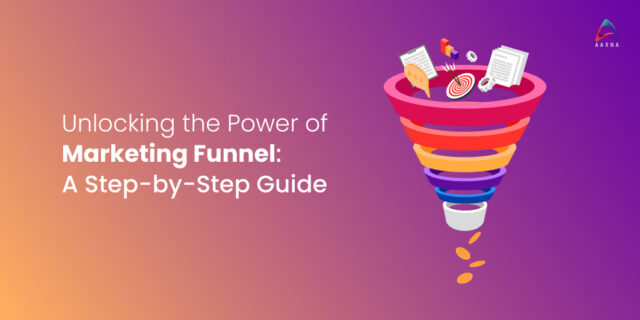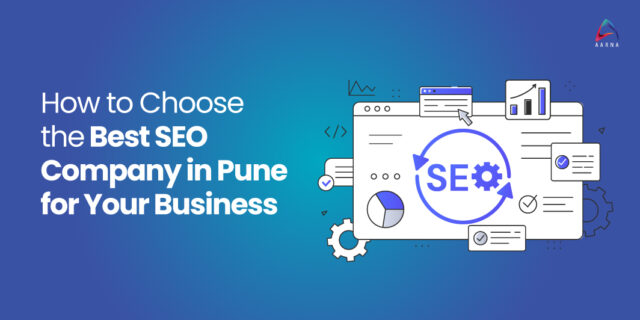Think of a time when you were considering buying a new smartphone. You probably did some research, read reviews, and maybe even visited a store.
Well, that’s the journey your target audience takes, too.
The marketing funnel is a powerful tool that helps businesses understand and guide their customers through the various stages of the buying journey. This marketing funnel remains a fundamental framework for guiding potential customers from their first interaction with your brand to becoming loyal advocates. At Aarna Systems, we understand that a well-structured marketing funnel is the key to maximizing your business’s potential. Let us help you delve into the essential stages of the marketing funnel: Awareness, Consideration, Conversion, and Retention and how mastering each stage can transform your business. Let’s begin!
4 Stages of a Powerful Marketing Funnel
Stage 1: Awareness
Objective: To make your target audience aware of your brand and what you offer.
Awareness is the first crucial step in the marketing funnel. It’s about making potential customers aware that your brand exists and piquing their interest.
Strategies:
- Content Marketing: Craft high-quality content that addresses the pain points and interests of your target audience. Blog posts, infographics, and videos are excellent tools to educate and inform. For example, a blog post detailing the top 10 solutions to a common industry problem can attract those looking for answers.
- Social Media: Leverage platforms like Facebook, Instagram, LinkedIn, and Twitter to reach a broader audience. Consistent posting and engaging content can help build brand visibility. For instance, sharing behind-the-scenes content or industry news can keep your audience engaged and informed.
- SEO: Optimize your website and content for search engines to ensure your brand appears when potential customers search for relevant keywords. This involves keyword research, on-page optimization, and building high-quality backlinks.
- Paid Advertising: Utilize Google ads, social media ads and other forms of paid advertising to reach your audience quickly and effectively. Well-targeted ads can place your brand in front of potential customers who are searching for solutions you offer.
Metrics to Track:
- Website Traffic: A spike in visits indicates that your awareness strategies are working.
- Social Media Reach and Impressions: These metrics show how many people are seeing your posts.
- Organic Search Rankings: Higher rankings mean better visibility in search engine results.
- Ad Impressions and Click-Through Rates (CTR): High impressions and CTRs indicate effective ad campaigns.
Example:
For instance, for a mobile phone buyer, the awareness stage is all about discovering that the product exists and understanding its basic features and benefits. This could involve the following decision-making process:
- The buyer realizes they need a new smartphone to replace their outdated device or to meet their evolving needs (e.g., better camera, longer battery life, more storage).
- They start searching online or seeing advertisements for the latest mobile phone models, learning about the brand and its key features.
- The buyer may come across informative content such as blog posts, videos, or social media posts that introduce the mobile phone and highlight its capabilities.
- Through these awareness-building efforts, the buyer becomes aware of the mobile phone as a potential solution to their needs, sparking their initial interest.
At this stage, the buyer is primarily focused on understanding the basic product information and determining if the mobile phone is a viable option worth further consideration.
Stage 2: Consideration
Objective: To engage your target audience and encourage them to consider your products or services as a potential solution.
Once you’ve successfully created awareness, the next step is to nurture your leads and guide them through the consideration stage. This is where you provide valuable information and demonstrate how your offerings can solve their specific problems.
Strategies:
- Educational Content: Develop informative and educational content that showcases your expertise and the value you can provide. This could include in-depth blog posts, webinars, case studies, or whitepapers that delve deeper into the challenges your target audience faces and how your solutions can address them.
- Product Demonstrations: Offer interactive product demos, either in-person or through virtual platforms, to allow potential customers to experience your offerings firsthand. This can help them visualize how your products or services can benefit their businesses or personal needs.
- Free Trials or Samples: Consider providing free trials or samples of your products or services to give potential customers a risk-free way to experience the value you offer. This can be a powerful way to build trust and overcome any hesitations they may have.
- Personalized Outreach: Engage with your leads through personalized outreach, such as email marketing, direct messaging, or even one-on-one conversations. This allows you to address their specific concerns, answer their questions, and position your offerings as the best fit for their needs.
Metrics to Track:
- Lead Generation: Track the number of leads generated through your consideration stage strategies, such as content downloads, webinar registrations, or free trial sign-ups.
- Engagement Metrics: Monitor engagement metrics like email open rates, click-through rates, and time spent on your educational content to gauge the effectiveness of your strategies.
- Conversion Rates: Analyze the percentage of leads that progress from the consideration stage to the conversion stage, as this will indicate the success of your nurturing efforts.
Example:
In the consideration stage, the buyer delves deeper into the mobile phone, evaluating its features, capabilities, and how it aligns with their specific requirements. The decision-making process may include:
- Conducting thorough research on the mobile phone, such as reading in-depth product reviews, comparing specifications with other models, and understanding the various features and functionalities.
- Seeking out educational content, such as product guides or webinars, to gain a deeper understanding of the phone’s technical capabilities, user experience, and how it can address their needs.
- Engaging with the brand directly, either through product demonstrations, free trials, or personalized outreach, to experience the phone firsthand and assess its fit for their usage scenarios.
- Considering factors like price, compatibility with their existing ecosystem (e.g., other devices, services), and the overall value proposition of the mobile phone.
During this stage, the buyer is actively evaluating the mobile phone and weighing it against their requirements, preferences, and budgetary constraints to determine if it is the right choice.
Stage 3: Conversion
Objective: To convert your leads into paying customers and close the sale.
The conversion stage is where your potential customers make the final decision to purchase your products or services. This is the critical moment when you need to provide a seamless and compelling buying experience.
Strategies:
- Streamlined Sales Process: Ensure that your sales process is straightforward to navigate. This may include having a clear and user-friendly e-commerce platform, optimizing your checkout process, or providing guided sales assistance for more complex offerings.
- Compelling Pricing and Offers: Develop pricing structures and special offers that are competitive and attractive to your target audience. This could include discounts, bundled packages, or subscription-based models that provide ongoing value.
- Social Proof and Testimonials: Leverage social proof, such as customer reviews, case studies, and testimonials, to build trust and credibility with your leads. Showcasing the success stories of your existing customers can help overcome any remaining objections.
- Personalized Sales Outreach: Empower your sales team to engage in personalized outreach, addressing any specific concerns or questions your leads may have. This personal touch can be the deciding factor in converting them into paying customers.
Metrics to Track:
- Conversion Rates: Track the percentage of leads that successfully convert into customers, as this is a key indicator of the effectiveness of your conversion strategies.
- Average Order Value: Monitor the average value of each customer transaction, as this can help you identify opportunities to upsell or cross-sell additional products or services.
- Sales Cycle Duration: Analyze the time it takes for leads to progress from the consideration stage to the conversion stage. This can help you optimize your sales process and identify any bottlenecks.
- Customer Acquisition Cost (CAC): Calculate the cost of acquiring each new customer, which can help you measure the efficiency and profitability of your conversion strategies.
Example:
In the conversion stage, the buyer is ready to make the purchasing decision for the mobile phone. The decision-making process at this stage may include:
- Finalizing the comparison between the mobile phone and other options, considering factors like pricing, available deals or discounts, and the overall value proposition.
- Reviewing any remaining concerns or objections they may have, such as warranty coverage, after-sales support, or specific feature requirements.
- Leveraging social proof, such as customer reviews and testimonials, to build confidence in the mobile phone and overcome any lingering hesitations.
- Engaging with the sales team or navigating the purchasing process on the brand’s website to complete the transaction.
At this stage, the buyer is ready to commit to the mobile phone, having gone through a thorough evaluation and feeling confident that it meets their needs and provides the best value.
Stage 4: Retention
Objective: To foster long-term customer loyalty and encourage repeat business.
The final stage of the marketing funnel is all about retaining your customers and turning them into loyal brand advocates. By providing an exceptional customer experience and continuously engaging with your customers, you can ensure they remain loyal and become valuable assets to your business.
Strategies:
- Exceptional Customer Service: Prioritize delivering exceptional customer service at every touchpoint, from initial inquiries to post-purchase support. Provide responsive, personalized, and helpful assistance to ensure your customers feel valued and satisfied.
- Ongoing Engagement and Communication: Maintain regular communication with your customers through channels like email newsletters, social media, or personalized outreach. Share relevant updates, industry insights, or exclusive offers to keep them engaged and informed.
- Loyalty Programs and Incentives: Implement loyalty programs or incentive schemes that reward your customers for their continued business. This could include exclusive discounts, early access to new products, or points-based reward systems.
- Cross-Selling and Upselling: Identify opportunities to cross-sell complementary products or upsell to higher-tier offerings that provide additional value to your customers. This can help increase customer lifetime value and strengthen the overall relationship.
Metrics to Track:
- Customer Retention Rate: Monitor the percentage of customers who continue to do business with your company over time, as this is a key indicator of customer loyalty and satisfaction.
- Customer Lifetime Value (CLV): Calculate the average revenue a customer generates throughout their relationship with your business. This metric can help you prioritize your retention strategies and identify your most valuable customers.
- Net Promoter Score (NPS): Measure the likelihood of your customers to recommend your products or services to others.
- Repeat Purchase Rate: Track the percentage of customers who make multiple purchases from your business, as this demonstrates the effectiveness of your retention strategies.
Example:
After the purchase, the buyer’s decision-making process shifts to ensuring a positive ongoing experience with the mobile phone and establishing a long-term relationship with the brand. This may involve:
- Evaluating the initial user experience and assessing whether the mobile phone is meeting their expectations in terms of performance, usability, and overall satisfaction.
- Seeking out any available customer support or after-sales services to address any issues or concerns that may arise during the ownership of the phone.
- Exploring any loyalty programs, incentives, or exclusive offers that the brand provides to encourage continued engagement and potential future purchases.
- Consider opportunities to further enhance their experience, such as purchasing complementary accessories or upgrading to a newer model in the future.
At this stage, the buyer’s decision-making is focused on maintaining a positive relationship with the brand and ensuring the ongoing value and satisfaction they derive from the mobile phone.
By understanding the buyer’s decision-making process at each stage of the marketing funnel, businesses can tailor their strategies and messaging to effectively guide the buyer through their journey, ultimately driving customer acquisition, engagement, and long-term loyalty to their products/business.
The Bottom Line
A well-executed marketing funnel can significantly impact your business’s success by guiding potential customers through a seamless journey from awareness to purchase and beyond. By focusing on each stage—Awareness, Consideration, Conversion, and Retention—you can ensure that your marketing efforts are strategic, targeted, and effective.
At Aarna Systems, the leading digital marketing company in Pune, we understand the importance of an effective marketing strategy in driving business growth. Our team of digital marketing experts specializes in crafting custom marketing funnels that are designed to engage your target audience and convert them into loyal customers. We take a data-driven approach to digital marketing, using the latest tools and technologies to analyze your audience and create personalized campaigns that resonate with them.
From lead generation to sales conversions, we’ll work with you every step of the way to ensure your marketing efforts are delivering measurable results. Whether you’re a small business or a large enterprise, we’re committed to helping you achieve your business goals through our tailored marketing solutions. Contact us today to learn more about how we can optimize your marketing strategy and take your business to new heights.


